Higher inclusion rates increase general performance
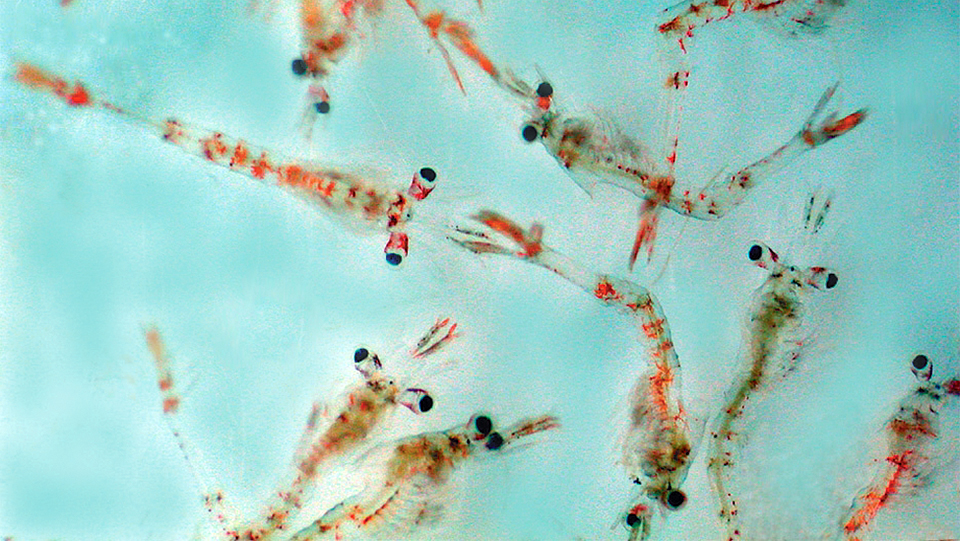
Shrimp larvae stop depending solely on their yolk reserves when they molt into the zoea stage and start deriving their required nutrients externally through feeding activity. In nature, the zoea and mysis stages depend on microalgae or a combination of microalgae and zooplankton as their major food sources. In hatcheries, live food is typically provided throughout these early larval stages to improve survival and growth results.
The continuous improvement of artificial, inert diets is significantly reducing the dependence on expensive microalgae and artemia cysts. Artificial diets also serve as research tools that allow the study of the nutritional requirements of larvae during the complicated ontogenetic and behavioral changes they undergo during larval development.
Live food factor
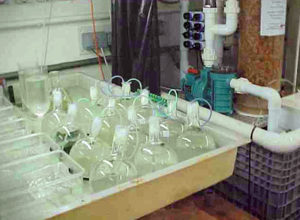
The complete substitution of live food under experimental conditions has been achieved with two commercially important penaeid shrimp species: Penaeus monodon and Marsupenaeus japonicus. But much information is still needed for a full understanding of the role of nutrition in shrimp larviculture.
For instance, the extraordinary biological value of live food cannot be entirely explained by analyzing its biochemical composition. This special value is referred to as the “live food factor” in algae, artemia, squid, etc. These live food factors can be nutritional components, enzymes, attractants, hormones, antimicrobials or something else.
Small-scale trial tests survival, disease resistance
During 2001-2002 at the University of Wales in Bangor, United Kingdom, a larval shrimp diet that included fresh and fresh-frozen marine ingredients formulated with an increased percentage of marine animal protein (diet F) was compared with a control diet, U. Table 1 shows the main differences in the formulation between feeds.
Wouters, Ingredient comparison between diets U and F, Table 1
| Ingredient | Diet U | Diet F |
|---|---|---|
| Fresh | 32% | 59% |
| Marine sources | 35% | 69% |
The authors tested diets at a 100 percent feeding rate with a single dose of algae in zoea I during larviculture of the penaeid shrimp Fenneropenaeus indicus. In a small-scale, experimental setup using 2-liter bottles to maintain the larvae, survival rates obtained at the end of this short culture test were 73.4 percent and 81.3 percent for treatments diets U and F, respectively (Table 2) – an excellent result at 100 percent feeding with artificial diets.
Wouters, Performance of Fenneropenaeus indicus larvae, Table 2
| Parameter | Diet U | Diet F |
|---|---|---|
| Survival (%) | 73.4a | 81.3a |
| Length (mm) | 29.4a | 3.02a |
Animals at mysis I were challenged with 105 CFU per milliliter Vibrio salmonicida during 36 hours to evaluate disease resistance. This Vibrio was proven pathogenic to juvenile shrimp in preliminary tests. As shown in Fig. 1, shrimp larvae fed diet F were more resistant (P < 0.05) to the Vibrio pathogen than those fed diet U.
Live-food substitution trial
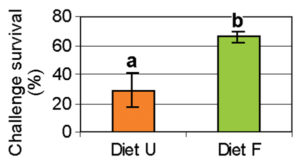
P. monodon were cultured from zoea I to postlarvae PL1 in a large-scale setup at the IATEC research facilities in Thailand. This setup included triplicate 3-metric tons (MT) concrete larviculture tanks run under typical commercial conditions. At the end of the trial, which fed the shrimp diets U and F, production variables were measured, but there were no facilities to perform a challenge test.
The trial demonstrated the possibility to substitute live food without jeopardizing commercial production results. No significant differences (P > 0.05) were recorded between treatments receiving 25 percent or 100 percent diet U.
Growth increase
The shrimp fed diet F outperformed shrimp fed diet U in terms of growth and larval development (Table 3), indicating a beneficial effect for fresh marine ingredients in larval shrimp diets. The most probable explanation for this positive effect was the better utilization of key nutrients by avoiding the double processing of premium marine ingredients.
Wouters, Performance of Penaeus monodon larvae, Table 3
| Parameter | Diet U | Diet U | Diet F |
|---|---|---|---|
| Live food substitution (%) | 25 | 100 | 100 |
| Survival (%) | 90a | 91a | 95a |
| Final dry weight (mg) | 61ab | 50a | 75b |
| Larval stage index | 7.0b | 5.5a | 6.4b |
During preparation of diet F, ingredients were not dried and milled into a meal, but included as fresh or fresh-frozen material directly into the processing line. This is also a good approach to retaining the attracting characteristics of marine ingredients.
Conclusion
A higher inclusion rate of fresh or fresh-frozen marine protein sources increases the general performance and live-food-replacing capacity of larval shrimp feeds. This can help reduce the dependence on cultured microalgae and artemia cysts during seedstock production at shrimp hatcheries.
(Editor’s Note: This article was originally published in the April 2003 print edition of the Global Aquaculture Advocate.)
Now that you've reached the end of the article ...
… please consider supporting GSA’s mission to advance responsible seafood practices through education, advocacy and third-party assurances. The Advocate aims to document the evolution of responsible seafood practices and share the expansive knowledge of our vast network of contributors.
By becoming a Global Seafood Alliance member, you’re ensuring that all of the pre-competitive work we do through member benefits, resources and events can continue. Individual membership costs just $50 a year.
Not a GSA member? Join us.
Authors
-
Roeland Wouters, Ph.D.
INVE Technologies NV
Hoogveld 93
B-9200 Dendermonde, Belgium[101,98,46,101,118,110,105,64,115,114,101,116,117,111,119,46,114]
-
Tille Van Horenbeeck, M.Sc.
INVE Technologies NV
Hoogveld 93
B-9200 Dendermonde, Belgium -
Greet Merchie, Ph.D.
INVE Technologies NV
Hoogveld 93
B-9200 Dendermonde, Belgium -
Peter Bridson, M.Sc.
University of Wales, Bangor
School of Ocean Science
Gwynedd, Wales
Tagged With
Related Posts

Aquafeeds
A look at phospholipids in aquafeeds
Phospholipids are the major constituents of cell membranes and are vital to the normal function of every cell and organ. The inclusion of phospholipids in aquafeeds ensures increased growth, better survival and stress resistance, and prevention of skeletal deformities of larval and juvenile stages of fish and shellfish species.
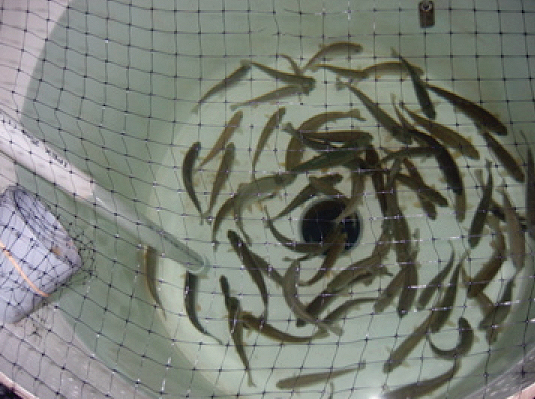
Health & Welfare
Algae shows promise as alternative DHA source in rainbow trout diets
A growth trial in Canada evaluated the use of algae biomass to increase the concentration of long-chain polyunsaturated fatty acids in the tissues of rainbow trout.

Innovation & Investment
Artemia, the ‘magic powder’ fueling a multi-billion-dollar industry
Artemia, microscopic brine shrimp used as feed in hatcheries, are the unsung heroes of aquaculture. Experts say artemia is still inspiring innovation more than 50 years after initial commercialization. These creatures are much more than Sea-Monkeys.
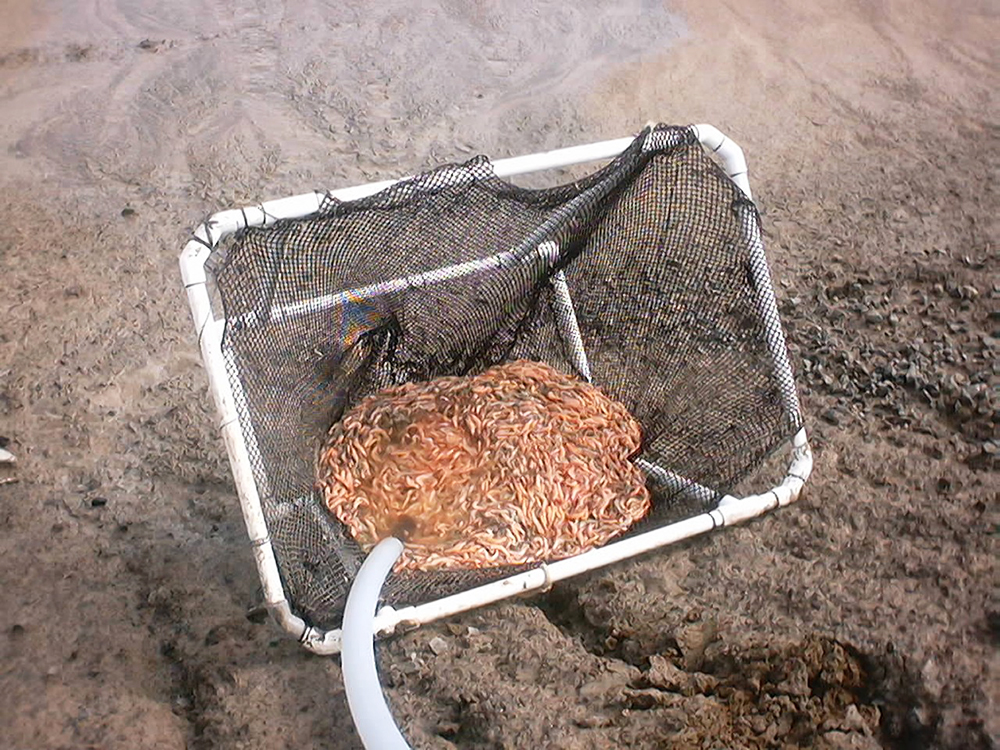
Aquafeeds
Biosecurity protocols needed for shrimp feeds, feeding practices
Shrimp aquafeeds – live, fresh or formulated – should not be an entry point of potential pathogens to the shrimp and/or to their culture systems.


